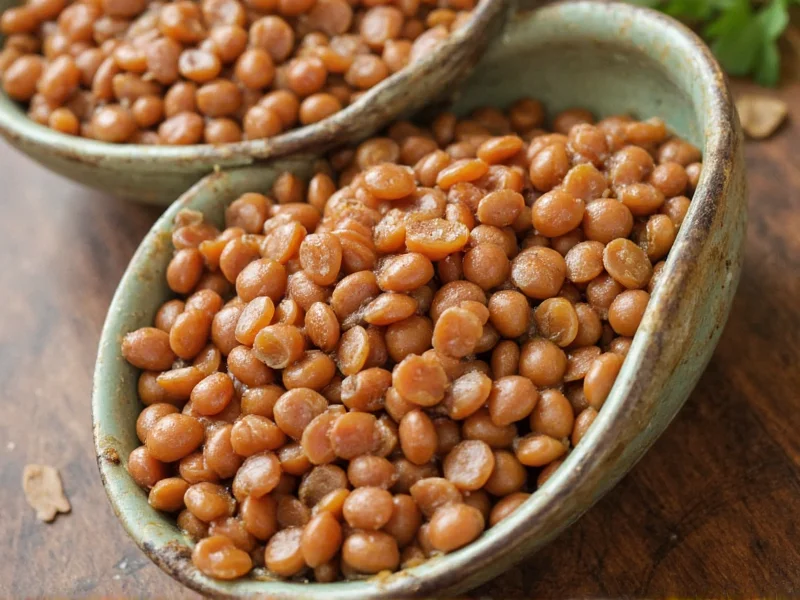Canned lentils provide a practical solution for busy households seeking nutritious plant-based protein without the time commitment of cooking dried beans. These shelf-stable staples undergo pressure cooking during the canning process, making them immediately usable in recipes while maintaining most of their nutritional integrity. Unlike dried lentils that require 15-45 minutes of cooking time plus soaking for some varieties, canned lentils eliminate these preparation steps while delivering similar health benefits.
Nutritional Profile of Canned Lentils
While some nutrient loss occurs during the canning process, canned lentils retain significant nutritional value. The liquid in the can typically contains water, salt, and occasionally calcium chloride as a firming agent. When comparing nutritional content, rinsed canned lentils maintain approximately 90% of the protein and fiber found in their dried counterparts.
| Nutrient (per 1/2 cup) | Canned Lentils (rinsed) | Home-Cooked Dried Lentils |
|---|---|---|
| Calories | 110 | 115 |
| Protein | 9g | 9g |
| Fiber | 6g | 8g |
| Sodium | 380mg | 5mg |
| Iron | 15% DV | 18% DV |
Practical Advantages of Canned Lentils
The primary benefit of canned lentils lies in their time-saving convenience without significantly compromising nutritional value. Busy professionals, students, and families find canned lentils particularly valuable for quick meal preparation. Most standard cans contain 15-16 ounces (about 400g) of product, yielding approximately 1.5 cups of drained lentils—enough for two to three servings in most recipes.
When evaluating shelf life of canned lentils, unopened cans maintain quality for 2-5 years when stored in cool, dry conditions. Once opened, transfer unused portions to a glass or plastic container and refrigerate for up to five days. For longer storage, freeze portions in airtight containers for up to six months without significant texture degradation.
Using Canned Lentils Effectively
Understanding how to cook with canned lentils properly enhances both flavor and texture. Always rinse canned lentils thoroughly under cold water before use to reduce sodium content by up to 40% and remove the starchy liquid that can affect recipe consistency. Gently pat dry with a clean towel when recipes require minimal moisture.
For soups and stews, add rinsed lentils during the last 10-15 minutes of cooking to prevent over-softening. In salads, combine with acidic dressings immediately after rinsing to help maintain firmness. When substituting canned for dried lentils in recipes, use a 1:1.5 ratio (one cup dried lentils yields approximately 2.5 cups cooked, while one 15-ounce can yields about 1.5 cups).
Comparing Canned and Dried Lentils
The debate between canned lentils vs dried lentils nutrition reveals minimal differences in core nutritional value. While dried lentils retain slightly more fiber and certain water-soluble vitamins, canned varieties offer comparable protein content and essential minerals. The sodium content represents the most significant difference, with canned options containing substantially more salt unless specifically labeled as "low sodium" or "no salt added."
From an economic perspective, dried lentils cost approximately 30-50% less per serving than canned varieties. However, this calculation doesn't account for water, energy costs, and time required for preparation. For those valuing convenience and immediate usability, best canned lentils brands provide excellent value despite the higher initial cost.
Simple Meal Ideas with Canned Lentils
Creating canned lentils recipes quick meals requires minimal effort. For a protein-packed salad, combine one drained can of lentils with diced cucumber, cherry tomatoes, red onion, and feta cheese, then toss with lemon-herb vinaigrette. The entire preparation takes less than 10 minutes.
Lentil soup requires only three additional ingredients: one can diced tomatoes, one chopped carrot, and vegetable broth. Simmer for 15 minutes with your favorite herbs for a complete meal. For a heartier option, blend rinsed lentils with roasted vegetables and spices to create instant vegetarian patties that hold together well for pan-frying.
Special Considerations
Individuals monitoring sodium intake should seek low sodium canned lentils options or thoroughly rinse standard varieties. Those concerned about BPA exposure may prefer brands using BPA-free linings, which many premium canned lentils brands now offer. For maximum freshness after opening, transfer unused portions to glass containers rather than leaving them in the original can.
When incorporating lentils into canned lentils for weight loss plans, their high protein and fiber content promotes satiety. A half-cup serving provides approximately 9 grams of protein and 6 grams of fiber for just 110 calories, making them an excellent component of balanced meal plans focused on sustainable weight management.
Do you need to rinse canned lentils before using them?
Yes, rinsing canned lentils significantly reduces sodium content by up to 40% and removes the starchy liquid that can affect recipe texture and consistency. Always rinse thoroughly under cold water in a colander before incorporating into recipes.
How do canned lentils compare nutritionally to dried lentils?
Rinsed canned lentils retain approximately 90% of the protein and fiber of home-cooked dried lentils. The primary difference is higher sodium content in canned varieties, though this can be reduced through rinsing. Dried lentils contain slightly more fiber and certain water-soluble vitamins.
What's the shelf life of canned lentils?
Unopened cans maintain quality for 2-5 years when stored in cool, dry conditions. Once opened, transfer unused portions to a sealed container and refrigerate for up to five days. For longer storage, freeze portions in airtight containers for up to six months.
Can I substitute canned lentils for dried lentils in recipes?
Yes, use a 1:1.5 ratio when substituting (one 15-ounce can yields about 1.5 cups of drained lentils). Add canned lentils later in the cooking process than dried varieties to prevent over-softening, typically during the last 10-15 minutes of cooking for soups and stews.
Are canned lentils healthy for weight management?
Yes, canned lentils provide excellent nutritional value for weight management with 9g of protein and 6g of fiber per half-cup serving for only 110 calories. Their high protein and fiber content promotes satiety, helping to control appetite and support sustainable weight management when incorporated into balanced meal plans.











 浙公网安备
33010002000092号
浙公网安备
33010002000092号 浙B2-20120091-4
浙B2-20120091-4